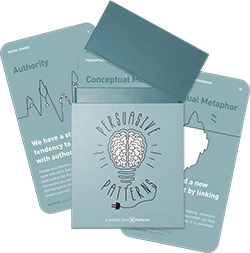Status
Design Pattern
Problem summary
We constantly look to how our actions improve or impair how others see us
Usage
- Use to direct members of a group toward desired behavior
- Use to reward users doing good deeds
This card is part of the Persuasive Patterns printed card deck
The Persuasive Patterns Card Deck is a collection of 60 design patterns driven by psychology, presented in a manner easily referenced and used as a brainstorming tool.
Get your deck!Solution
Regardless of our income or social standing, we look for ways to improve and retain our status. We crave belonging and gathering status labels reinforces this. Acknowledging a person’s position in a group can inject confidence in the individual and act as a behavioral reference point for others.
- Let users gauge and express their standing. Provide feedback loops and measures to let people know how they are doing and consider how you can give users a chance to express it. Highlight successful acts that others should follow and provide positive feedback when others follow suit.
- Let users protect their status. We act when our status seems in jeopardy, so be careful not to present status linked to undesired behavior.
- Show relative status. The status level of a user only has meaning if it is relative to status levels of other users on the platform. Status can work in levels, although it does not have to be hierarchical. Consider branching out status to let users take on various roles.
Status relates to our standing relative to others or our personal best and can be both personal (income, performance, etc.) and public (scoring, recognition, etc.).
Rationale
We constantly assess our social or professional standing relative to others, seeing how interactions either enhance or diminish it
Status and our wish to conform to it is a foundational conncept of social psychology. We use status to help determine to which level we as an individual should conform. Individual variations among group members play a key role in the dynamic of how willing people will be to conform or oblige.
1 Bickman, Leonard (1974). The Social Power of a Uniform. Journal of Applied Social Psychology. 4 (1): 47–61
2 Baron & Branscombe (2012). Social Psychology. United States of America: Pearson Education, Inc. pp. 127–28
User Interface Design Patterns
- Forms
- Explaining the process
- Community driven
- Tabs
- Jumping in hierarchy
- Menus
- Content
- Gestures
- Tables
- Formatting data
- Images
- Search
- Reputation
- Social interactions
- Shopping
- Increasing frequency
- Guidance
- Registration
Persuasive Design Patterns
- Loss Aversion
- Other cognitive biases
- Scarcity
- Gameplay design
- Fundamentals of rewards
- Gameplay rewards


